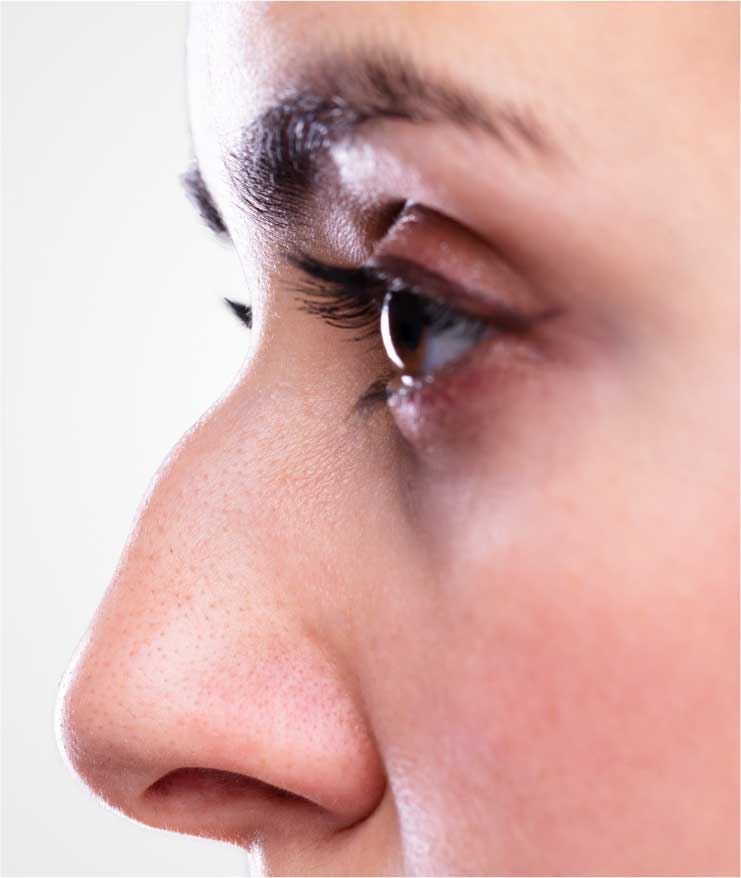NON-SURGICAL RHINOPLASTY
Non-surgical rhinoplasty is another name for a temporary nose job. We can perform this treatment at Dr Grace Kelly Aesthetic Skin Clinic in Gerrards Cross, Buckinghamshire, providing a safe and effective alternative for those who do not wish to go under the surgeon’s knife.
Why do people have non-surgical rhinoplasty?
Like its surgical relative, this treatment can improve the shape and size of a person’s nose. However, instead of making a correction, this procedure will disguise the appearance of a number of concerns, including: crooked nose, large nose, small nose, bump on the nose, large nostrils and a flat bridge – characteristics that are genetic or are the result of trauma or injury. Being ‘non-surgical’ means it’s significantly less invasive than the surgical option, and is performed much quicker (as little as 30 minutes). Recovery is fairly rapid and patients can often continue with their usual routine within 24-48 hours; compared with the surgical procedure which often involves a recovery time of 2-3 weeks. Side effects can include swelling and bruising, but this is quite mild in comparison to the side effects of surgery, and there is virtually no scarring to consider.
As a non-surgical rhinoplasty is temporary, many patients use this treatment to get an idea of how their new nose will look before they go ahead with a permanent surgical alteration.
How is non-surgical rhinoplasty performed?
We use dermal fillers to carry out this treatment, injecting a smooth gel into various places on and around the nose. During our initial consultation we discuss the patient’s concerns which helps us to establish the exact placing of the filler so we can achieve the desired end result. We apply the fillers to the soft tissue just beneath the surface of the skin, and injection points may be placed along the bone structure, at the tip or around the nostril area (or a combination). A topical numbing cream can be applied to the skin before the procedure to help numb the area and make it more comfortable.
What type of Dermal filler is used?
Hyaluronic acid fillers are the preferred choice for both patients and practitioners, and most brands will have HA fillers available. These dermal fillers can come in a range of densities, which are often chosen to treat different areas of the face. High density fillers are most suitable for this procedure as they are firmer and are more likely to hold their shape. They work well when looking to build on the facial structure, which is beneficial when we’re looking to achieve straight lines or improve the size and shape of the tip.
High density HA fillers have the same dissolving properties as less dense fillers, and after several weeks or months, they will start to fragment. The product will absorb into the body’s drainage system which is flushed out naturally.
This unique quality means we can also disperse the product by using a hyaluronidase solution which speeds up the process, and effectively reverses the procedure.
What can I expect from the results?
Our doctors are highly skilled and carry out the non-surgical rhinoplasty with precision. As previously mentioned we place the gel where it’s needed, reshaping either the soft tissue beneath the skin, the bone structure or both. The filler effectively adds volume beneath the skin which can disguise an irregular structure or make specific areas larger in appearance, such as the tip (which can be made to look lifted). However, this concept can produce the reverse effect as cleverly placed filler on the bridge can create an illusion that appears to make the nose look smaller. After the treatment is complete, you’ll need to make sure that touching, rubbing or applying pressure to the nose is avoided for up to 6 hours. This enables the filler to settle in place and reduce the chance of filler migration – when the product shifts to a different position. Wearing glasses can also put weight on the nose, and disturb the placing of the filler. Dr Grace Kelly’s experts will provide additional advice to those who wear spectacles to help with this issue. Other things to avoid include: strong sunlight / prolonged sun exposure, alcohol, saunas, sunbeds and applying make-up for 2 days.
The approach we take depends on the patient’s individual concerns, and our personalised treatment plans outline how we’ll achieve the expected result. Dermal fillers will give an instant outcome, and when any minor swelling and bruising has disappeared (usually 3-5 days), the newly formed nose will be visible. The treatment is expected to last between 6 and 18 months when a repeat procedure is required.
For more information about non-surgical rhinoplasty, or to book a consultation, visit our website https://drgracekelly.co.uk/treatments/non-surgical-rhinoplasty/ or contact the clinic today!

